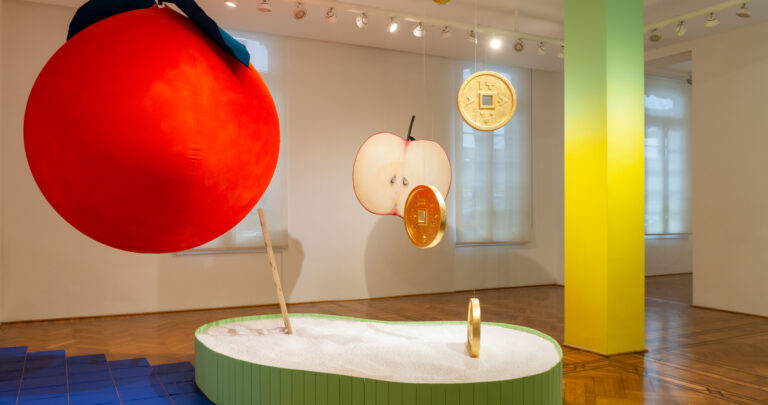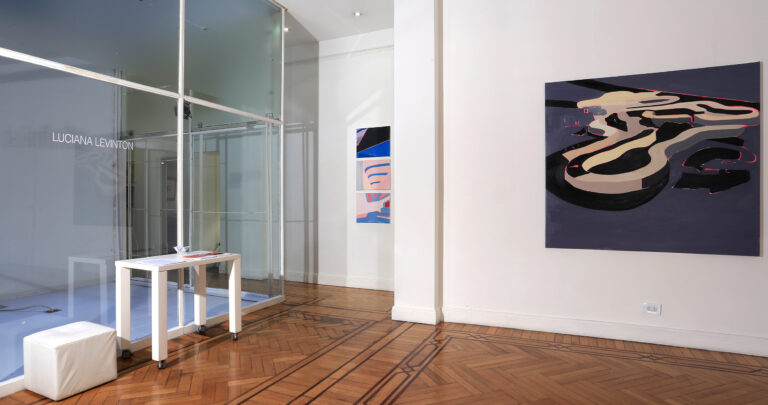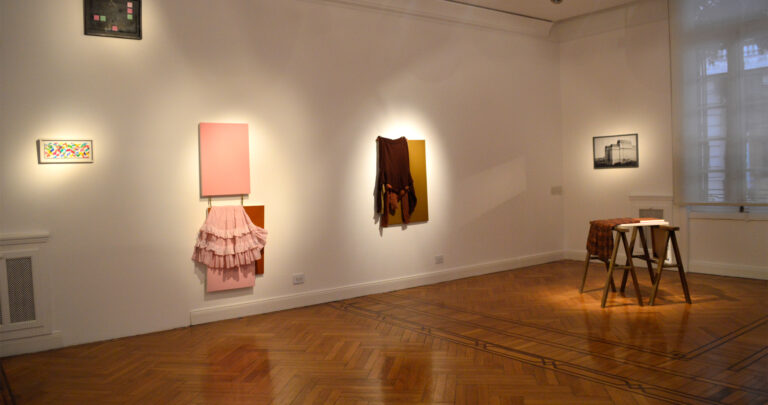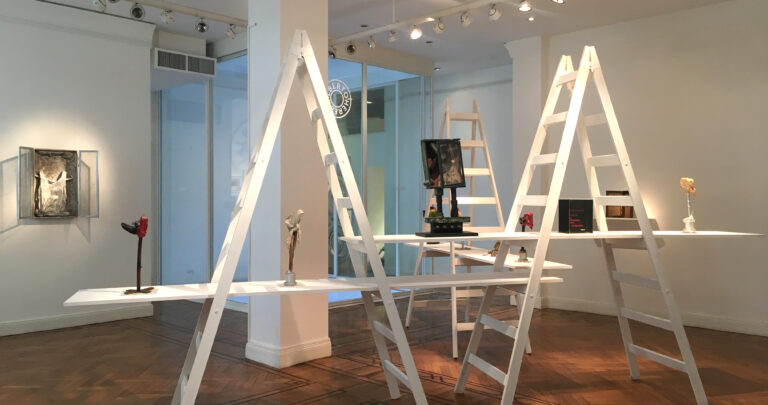curatorial text
Eduardo Stupía
Inside, the shapes. They move alone
From the point of view of potency there is no reason to introduce a difference between the reasonable man and the insane man. This does not mean that they have the same potency, but that each one, in itself, realizes, effects his potency. Each one strives for persevering in his being, that is, makes his potency.
Gilles Deleuze, in the middle of Spinoza, Editorial Cactus, Buenos Aires
This is a love story; for twenty years Fabiana Imola has coordinated an art workshop in the Cultural Area of the Psychiatric Colony “Dr. Abelardo Irigoyen Freyre” in Oliveros, Province of Santa Fe, where hospitalized patients participate. The practice of art is a great healing tool, but the certainty that psychosis, or even the less radical variants of these pathologies, are powerful and irreducible, is no less accepted.
In any case, while Imola patiently and passionately developed drawing sessions in the same institution where the workshop was held, someone still without a name silently and compulsively produced drawings with colored pens on loose papers and medicine boxes. That someone was as the others but rarely different, he was not exactly a patient but he was not something else either, at first he was not part of the workshop groups.
His graphic motifs are unclassifiable and codified, established on geometric lines that are sometimes rigorous, sometimes distorted and arbitrary. The surface of the page twitches loaded with signs, icons, geometries, anomalous figural perimeters, schematic characters, physiognomies and, very especially, apparently unconnected words and phrases. Sometimes incomprehensible and other times remarkably revealing, these phrases drawn with an unprecedented calligraphy with a flamboyant appearance and rare corporeality, can be both absurd and allusive to political or public references. Terms from the clinical language of prospects and laboratories can be found very frequently imbued with an obsessive mysticism and an obscure referentiality.
Imola carried out a task of support and encouragement that included the fact of providing the materials for the production of this tireless work. She also noticed the type of bond that the author had with the different people inside the hospital. With a lovely attitude of detective thoroughness, Fabiana started to discover details of the artist’s life; of how he initially helped with hospital tasks, looking for packages or taking care of cars, for example. Meanwhile, he gave his drawings to different people and someone, fortunately more careful, put them together. Unfortunately, a good number of previous drawings, now lost, had been delivered by him to a psychologist, and also, in the middle of a move, dozens of drawings made on medicine boxes were thrown away. Fabiana Imola gradually develops a bewildered relationship with this unique character and warns that she must support him in that irrepressible drive practice of drawing. In this exercise there is something transcendent and even of a performative nature, qualities that far exceed the typical classification of the so-called “Art Brut” or “Alienated Art”.
It is time to interact with the workshop and the other members. Fabiana shows him how other patients participate by painting. He agrees to go mainly to look for materials, but also to talk about the work. The approach to this common work environment and the consequent talks induced him to introduce changes in the dimensions of the work and in the choice of the typical pens with which he drew. Starting from those with basic palettes (black, blue and red) he moves on to more modern options with more varied colors such as magentas, greens and fluo colors. Together with the task of rescue and shelter that Fabiana undertook as she got to know this abundant production, she developed a kind of clinical practice, of accompaniment, which immediately leads to a broader validation process than what it was till that moment: a wonderful and at the same time unknown discovery. Imola today underlines how amazing was to see how all that work began to stand out, to become known, generating enormous repercussions and great interest in an entire community of artists.
This is how in 2003 a first exhibition takes place, positioning him not only as an artist but as a subject. This necessarily matches with the laborious procedures to manage his ID card, documentation of which he completely lacked. Our artist now has a first and last name: Aníbal Brizuela. Anonymous had entered the hospital and anonymous had remained for fifty years. Then begins a period of phenomenal expansion and development that coincides with the interest of the filmmaker and documentary filmmaker Rubén Plataneo, who in 2011 premieres the film Tanke Papi. This film tells the story of Brizuela and the journey and inscription of his work on the stage of contemporary Argentine art. On the occasion of this first exhibition, Brizuela leaves the hospital for the first time and remains standing next to his drawings during the hole opening. From there, it can be said that the work will support him.
The exhibition Inside, the forms. They moves alone, presented by Del Infinito gallery, re-enacts in the brightest and most proactive way the versatile relationship between Aníbal Brizuela and Fabiana Imola. The dynamic binding counterpoint of the conceptual and formal resonances between the work of both is also the mirror of a spiritual bond sustained over a long and fruitful period of time. Of course, and since this is a love story, with her proverbial generosity, Imola gives Brizuela center stage. There is then the theater of fantastic appearances, graphic constellations and ideogrammatic elocutions that constitute the disturbing and hypnotic physiognomy of this overwhelming artist. In an intimate, secret and at the same time beautifully sonorous dialogue, the metallic corporeities of Fabiana Imola coexist with the universe of Aníbal Brizuela, which, in their changing morphology, are at the same time sign, object and character.
view more
exhibition




press
other exhibitions
Axel Straschnoy, Beto De Volder, Clorindo Testa, Emilio Pettoruti, Enio Iommi, Esteban Pastorino, Gyula Kosice, Manuel Espinosa, Marcela Cabutti, Matilde Marin, Rogelio Polesello, Romina Ressia, Romulo Macció · 12.12.2023 - 15.02.2024
Indefinit

Axel Straschnoy · 02.11.2023 - 29.12.2023
Brave the Heavenly Breezes

André Komatsu, Enio Iommi, Clorindo Testa · 23.08.2023 - 31.10.2023
Hiato

Mariela Vita · 12.07.2023 - 16.08.2023
GEJIGEJI

Polesello, Aizenbeg, Kosice, Vardanega, Le Parc, Iommi, Puente, Arden Quin, Espinosa, Demarco, Straschnoy, De Volder, Pastorino, Imola, Batistelli, Cabutti, Reyna · 09.02.2023 - 15.03.2023
Eléctrico/ ecléctico

Romina Ressia · 09.06.2022 - 25.08.2022
Grow flowers

Martín Reyna · 11.03.2022 - 03.06.2022
Color in transit

Matilde Marín · 08.02.2022 - 02.03.2022
25FPS

Clorindo Testa · 11.11.2021 - 31.01.2022
Testa, projects and other games

Cabutti, De Volder, Reyna, Imola, Ventoso, Ressia. · 05.10.2021 - 22.10.2021
Group Show 2021 II

Matilde Marín · 23.07.2015 - 21.09.2015
Undetermined landscapes

Marcela Cabutti · 16.07.2021 - 22.09.2021
Balcarce, topographic memories of a landscape

Benito Laren · 12.05.2012 - 22.06.2012
Casino

Lila Siegrist · 26.06.2012 - 27.08.2012
Vikinga Criolla

Cárdenas, Imola, Marin, Res, Sommerfelt, Ventoso · 10.08.2012 - 11.10.2012
Morphological confrontations

Martin Reyna · 20.09.2012 - 20.11.2012
Reyna in the horizon of color

Romina Orazi · 04.12.2012 - 04.02.2013
Subject to infinite division

Aizenberg, Boto, Espinosa, Iommi, Lozza, Le Parc, Kosice, Silva, Tomasello, Vardánega · 01.06.2013 - 31.07.2013
Dimensional

Antoniadis, Marín · 07.09.2013 - 07.11.2013
Double contrast

Andrés Sobrino · 28.03.2013 - 30.05.2013
Andrés Sobrino

Antoniadis, Cabutti, Laren, Reyna, Florido, Sobrino, Straschnoy, Tarazona, Ventoso · 20.12.2013 - 15.02.2014
Universus

Elena Dahn · 25.03.2014 - 26.05.2014
Elena Dahn

Marcela Cabutti · 15.07.2014 - 15.09.2014
Finding meaning through shapes

Axel Straschnoy · 12.11.2014 - 19.01.2015
La Figure de la Terre

Fusilier, León, Quesada Pons y Vega · 15.03.2015 - 30.04.2015
Limbo

Luciana Levington · 28.05.2015 - 24.07.2015
Luciana Levinton

Leo Battitelli · 12.11.2015 - 12.01.2016
Gargalhadas

Hasper, Scafati · 10.02.2016 - 11.04.2016
Womens’ double

Axel Straschnoy · 12.05.2016 - 13.06.2016
Today, great tomorrow!, in the pines wind blows from the past.

Arden Quin, Boto, Demarco, Espinosa, Iommi, Le Parc, Lozza, Polesello, Puente, Silva, Testa, Tomasello · 07.06.2016 - 05.08.2016
Masters of the avant-garde

De Volder, Sobrino · 11.08.2016 - 10.10.2016
Andres Sobrino and Beto De Volder

Battistelli, Cabutti, Cacchiarelli, Sobrino, De Volder · 02.01.2017 - 28.02.2017
2017 Group Show

Fabiana Imola · 28.02.2017 - 14.04.2017
The forest, the rain and other scenes

Alberto Heredia · 06.09.2017 - 11.10.2017
Alberto Heredia

Federico Manuel Peralta Ramos · 31.10.2017 - 29.12.2017
Federico Manuel Peralta Ramos

Marcela Cabutti · 10.11.2017 - 31.01.2018
About the effective distance between objects

Luciana Rondolini · 15.02.2018 - 15.04.2018
End

Estanislao Florido · 27.04.2018 - 01.07.2018
The disenchanted object

Battistelli, Cabutti, Marín, Straschnoy, Ventoso, De Volder · 06.07.2018 - 31.08.2018
2018 Group Show

Rogelio Polesello · 06.09.2018 - 20.12.2018
Vortex

Cabutti, Imola, Marín, Reyna, Rondolini, Straschnoy, De Volder · 27.02.2019 - 03.04.2019
2019 Group Show

Alberto Greco · 04.04.2019 - 31.08.2019
The bad handwriting

Matilde Marín · 25.09.2019 - 31.12.2019
As the blue smoke of Ítaca is spotted

Esteban Pastorino · 10.09.2020 - 29.01.2021
Pastorino

Marín, Imola, De Volder, Reyna, Florido, Straschnoy, Pastorino · 08.02.2021 - 01.04.2021
2021 Group Show

Alberto Greco · 06.04.2021 - 30.06.2021
LA PITTURA È FINITA. Poses and impostures of Alberto Greco in Italy
